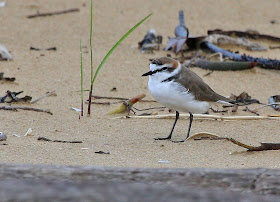I arrived a day early so that we could check out the sites for the field sessions.

My hosts the first day were Sim and Daniel. Here they are at the first site - Kampung Skudup, Chupak - which has an area of freshwater paddyfield habitat.

Note the low rain-filled clouds. These were to play a prominent part in the workshop!

Digiscoped
Apart from the ubiquitous Wood Sandpipers, there were a few Pintail/Swinhoe's Snipe about.

White-breasted Woodswallows are common residents.

However, I was really surprised to see Greater Painted Snipes there in numbers, as the species isn't on the checklist of birds of Sarawak I had consulted. Apparently this is an error in the list rather than a first record!


Painted Snipes are one of a select group of waterbird species where the female is brighter than the male. She takes no part in incubating the eggs or rearing the young once the eggs are laid, and she is 'polyandrous', mating with several males. This female sat obligingly next to the road, though unfortunately, against the light.

From Chupak we moved to Bako-Buntal Bay, a large bay just east of Bako National Park.

Digiscoped
There was a good selection of plovers on the sandbar, including several Kentish Plovers - this one a nice male...

Digiscoped

Digiscoped
...and several resident Malaysian Plovers.

This is a male, with the black collar going all the way round the back of the neck.


This one looks like a female, but it has some black feathers in the breast patches and on the forehead, so it may in fact be a 1st winter male.

This species preferred to roost on the driftwood, which made for some interesting photo opportunities.

A close view of a male.

Digiscoped
Sand Plovers were a couple of species we would be focusing on identifying during the workshop. Here, the difference in bill size between Lesser and Greater (right) is very apparent.


We were delighted to find that all the egrets roosting offshore were Chinese.

Digiscoped
A Whimbrel with a deformed leg fed near our watchpoint. The bird's handicap had probably prevented it from migrating north last season, and may also have prevented it from moulting. Consequently the plumage was extremely worn and bleached.

The non-pigmented areas (white) have largely worn away, and much of the dark areas of plumage has been bleached by the sun. Feathers in this condition will not be able to provide much insulation from the heat and cold, nor waterproofing, and this makes it vulnerable to an early death.

Digiscoped

Digiscoped
I was very happy to find a single "White-faced" Plover roosting on the beach. As far as I know, this is the first record for Borneo of this taxon (whether a full species or a race of Kentish remains to be seen). It differs from Kentish in having pale flesh-coloured legs, generally paler upperparts, whitish fringes on the coverts, very little brown on the ear coverts below the eye and restricted lateral breast patches. For more information, see here.
No comments:
Post a Comment